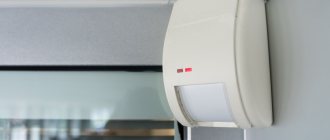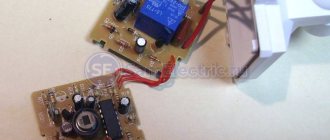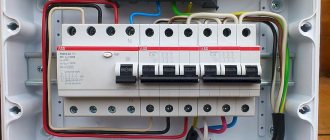Motion sensors (hereinafter referred to as motion sensors) gained worldwide recognition in the 90s of the last century. With their appearance on the radio engineering market, universal devices solved the important problem of saving energy and significantly extending the “life” of lighting devices. Today, household infrared radiation detectors are widely used to illuminate local areas, entrances, staircases and premises for various purposes. However, devices may break during operation. Many novice home craftsmen are interested in how possible it is to repair a motion sensor with their own hands.
What you need to know and be able to do
Before you start repairing an electrical appliance, you need to check that it is working properly. To do this, you need to know its structure, the location of the component parts and the connection diagram. If the sensor was installed by the previous owner, then you should study the passport data. The documentation provides detailed instructions for installation and adjustment, as well as a diagram for connecting the device to the electrical network and the lamp. If there are none, everything can be found on the Internet under the DD brand.
Typical DD scheme:
How does an IR detector work?
The operating principle of an infrared motion sensor is based on recording changes in the density of thermal radiation in the controlled space using a Fresnel lens. As long as the infrared background of the room is stable, the sensor is in standby mode. As soon as a person enters the room, the level of thermal radiation changes the balance towards increasing the IR flux. This will cause a change in resistance in the lens, which will give a signal to the relay, which in turn will turn on the light. When the movements of people in the room stop, the reverse process will occur, and then the light in the room will go out.
Operating principle of the IR sensor:
Automatic lighting control sensors
- They become blind in the hot season - false alarms are possible, for example from warm air flows (wind), fumes from heaters and even drafts.
- They may not work on a person who has entered the room from the street in hot weather, as well as against the background of windows and other sources of thermal radiation. Based on this, the accuracy of motion detection is not very high.
Light sensor (photo relay)
Light sensors, or photo relays as they are also called, have found wide application in the field of outdoor lighting control. For example, where it is desirable for the light to be on constantly. The principle of their operation is based on the fact that the photosensitive element changes its conductivity depending on the degree of illumination. The following elements are used as such an element:
Most often they are called “photo relay” or “twilight switch”. Common models of these sensors are labeled as FR-601, FR-01, etc.
What could cause a malfunction in the operation of the DD?
We need to find out why the problems arose.
This may happen after:
- voltage surge in the network;
- emergency shutdown and restoration of power supply;
- the appearance of a burning smell;
- falling of the device on the floor;
- children's games (imbalance of adjustment screws, change in orientation of the sensor lens).
Correct viewing angle setting:
To identify the reasons why the motion sensor does not work, we will analyze it.
To do this you need:
- Remove the cover of the device (you will need a Phillips screwdriver).
- Then release all the wires from the blocks, remembering their original position. It’s better to take a sketch or photo on your phone.
- Next, conduct a study of the power and low-current boards.
Connecting DD via pads:
Visual-tactile diagnostics
Repair of motion sensors may be limited to identifying damaged radio components and replacing them as a result of visual-tactile diagnostics of the infrared sensor. The device is disassembled and placed on the desktop under the light of a table lamp, armed with a magnifying glass: Check the integrity of the radio elements. There should be no swollen containers, darkened, cracked or loose elements. The smell of something burning will indicate the presence of burnt parts. They are clearly visible on the board.
The board track may burn out. Cracked, burned and broken grooves are restored by soldering jumpers. Analysis of the breakdown will help to avoid further malfunctions in the detector.
Troubleshooting:
It is necessary to check the soldering of all radio elements. A tactile inspection reveals poorly secured elements on the board, and they are soldered again. All suspicious parts are replaced with new elements.
Common malfunctions and how to eliminate them For motion sensors for lighting, the most typical manifestations of operational failure can be characterized as follows:
- The lamp does not turn on.
- The sensor does not turn off the light.
- False alarm.
- Sensor orientation is incorrect.
DIY assembly and repair methods
All motion sensor circuits for DIY lighting involve simple assembly using a small number of parts. All of them are inexpensive and can be purchased at any specialty store.
The simplest option
For beginners in this business, it is better to use the simplest assembly scheme and make a basic sensor that responds to movements. With its help, you can learn the basics that will help you further develop and improve your skills. All this will also help when repairing the device.
The following items will be used in the work:
- voluminous body (suitable for an old camera or any other similar equipment);
- control base, which can be bought in a store or removed from an old device;
- soldering machine;
- wires of different diameters;
- screwdriver;
- screws.
The control base can also be found at a flea market or from people who professionally repair old and new electrical appliances. It is inexpensive, so the purchase will not be an inconvenience even for the poorest people.
Step-by-step assembly instructions:
- A weak oscillation generator is assembled on the basis of a transistor.
- Then a low-pass filter and a capacitor are attached. Thanks to them, the impulse will be sent to the alarm contacts.
- After this, a resistor is installed that will help adjust the sensitivity of the device.
- A stabilizer is added to the general circuit to increase the signal.
- The next step is to attach a zener diode and a small relay.
- At the top of the board there is an antenna, which is carefully treated with degreasing compounds and polished. In addition, you can additionally coat it with rosin, which will prevent oxidation during operation.
- A small cross-section wire is taken (approximately 0.2 or 0.23 mm), and two coils are wound with it.
- The sleeve is carefully screwed to the hole in the center of the sensor and securely fixed.
- Then the housing is adjusted to the desired size. For this, all necessary measurements are taken.
- Then the center is marked and a hole is drilled in it.
- A light or sound source is attached to the detector, which will serve as an alarm.
Laser device
Despite the initial complexity, such a sensor is quite simple to assemble. The work can be done without any problems even at home. The mechanism itself consists of two devices connected to each other: a laser sensor that emits a light beam, as well as a sensor that receives it. The operating principle is based on the effect of a light source on a photocell. As soon as the flow is interrupted (a person passes or a car passes), the circuit closes and the light or alarm turns on. This device is ideal for protecting particularly important objects, the entrance to which is strictly limited.
The lamp does not turn on
If the DD does not turn on the light, then you need to check the current flow to the low-current board. This is easy to do using a tester. Having made sure that there is voltage at the input of this circuit, move on to the tuning regulators. Typically, there are three screws on the device body with the following symbols:
- SENS - it regulates the sensitivity of the pyro receiver;
- TIME — sets the delay time for turning off the lighting;
- LUX - sets the threshold for the level of illumination.
IR detector settings screws:
The device is connected to the network and to a 40-60 W lamp. The adjusting screws are brought to the extreme maximum position, gradually decreasing the values of all three adjustments. This achieves optimal operating conditions. You can adjust the settings in the opposite direction from the minimum values.
Adjustments on the ceiling detector body:
If there is no response from the device, check the power supply to the power circuits. They test the relay, that is, establish the presence of voltage on its coil. For safety reasons, the test is carried out with the low-current board completely disconnected. Next, they close the base with the emitter of the transistor and make sure that it is closed, while the relay should be turned off. The base is connected to a constant voltage through a resistor, and the transistor should open and the relay will operate. If none of the above processes occur, then the transistor must be replaced.
Main signs of sensor malfunction, possible causes
- unauthorized activation, at any time without any reason;
- does not turn off the lighting lamp;
- does not turn on the lighting lamp or other terminal devices, and does not respond to obvious signs of movement in its field of view.
Sequence of troubleshooting and troubleshooting
In any case, you need to start by inspecting the appearance to see if there is any obvious mechanical damage to the optical system of the Fresnel lens, or a simple layer of dust and dirt. If necessary, clean the lens and check the functionality of the sensor. This is the most common and simplest cause of malfunction. If there is no positive result, you will have to perform more complex operations:
- Use a multimeter or other devices to check the presence of incoming power at the input of the printed circuit board.
- If there is power, simulate the conditions under which the sensor should operate. Set the average lighting level at which the sensor is triggered in the dark and daylight, the maximum sensitivity level and the minimum operating interval.
- If in this position the sensor begins to operate, gradually set the desired parameters from the sensitivity level, then lighting and operating time. Periodically checking the response to the source of movement.
- After these operations, if the result is negative, turn off the power to the electrical circuit, remove all decorative elements and carefully inspect the printed circuit board.
- Areas of burnt elements, integrity of wires and jumpers, and reliability of soldering of radio components are identified. It is recommended to do this with binocular glasses or a magnifying glass. If you find poor-quality soldering, solder the contacts of the dropped elements. After this, check the functionality of the sensor.
- If you find burnt-out elements, replace them, having first checked the parameters of the neighboring ones involved in the circuit chain.
- If, when simulating driving conditions, the relay is activated, a characteristic click is heard, and the lamp does not light up, it means that the circuit between the relay contacts and the lamp is faulty, ring it. The relay contacts may have oxidized; replace it or clean the contacts. I do not consider the lamp to be faulty; this needs to be checked first.
- Measure the DC voltage after the converter; depending on the sensor model, it can be from 8–24 V (see diagram and other documentation). The measurements are carried out relative to zero; it is convenient to take the “-” diode bridge on the boards.
- If there is no required voltage, ring the elements in the converter circuit, most often these are diodes of the rectifier bridge.
Expert opinion
Viktor Pavlovich Strebizh, lighting and electrical expert
Any questions ask me, I will help!
In order for the device to correctly respond to movement and not react to interference, the movement of pets or branches outside the window, it is important not only to install it correctly, but also to configure it correctly. If there is something you don’t understand, write to me!
The sensor does not turn off the light
In this case, first turn to adjusting the settings. You can try to repair the sensor by adjusting the SENS and TIME screws. Due to incorrect settings of these parameters, the lighting may not go out. The fact is that if the rotary lever is set to the extreme right position, the relay will stop opening the power supply circuit of the lamp.
Pyroelectric sensor:
Violation of the DD operating mode may occur due to the appearance of residual load. Then the functionality of the device is restored by disconnecting it from the power supply for 10-15 seconds. If this is the reason, the sensor will work in its original mode. If the detector still does not turn off the light, check the operation of the relay. If a defect is detected in this part, it is replaced with a new device.
False alarm
Over time, the infrared sensor can take on a life of its own. Regardless of whether there is movement in the room or not, it automatically turns the lights on and off. False positives can be caused by both direct and indirect reasons. These can be powerful heat flows emanating from various heating equipment, or jets of cold air from air conditioners. Therefore, when installing the device, you should avoid close proximity to ventilation and air conditioning systems. The multilens should not be exposed to direct sunlight, which can interfere with the detector settings.
Operating principle of the IR detector:
Excessive cluttering of the viewing area of the device with furniture or other large objects can cause involuntary switching off or, conversely, switching on the lighting. Also, the increased sensitivity of the DD will cause it to be triggered by the movement of pets and even flying parrots. To prevent this from happening, the sensor is installed in the place of maximum access to the entire internal space of the room and the sensitivity level is reduced by turning the SENS screw counterclockwise.
Configuring and adjusting device settings
In order for the device to correctly respond to movement and not react to interference, the movement of pets or branches outside the window, it is important not only to install it correctly, but also to configure it correctly.
Viewing angle
Sensitivity (SENS)
This switch allows you to reduce the number of false alarms from pets, tree branches outside the window and other factors. Adjustment for this factor begins with the minimum value of the switch, followed by an increase to the desired value. All this is done experimentally with mandatory testing.
Shutdown delay (TIME)
Light level (LUX/DAY LIGHT)
Setting this parameter is made to adjust the switching on of the lighting device at a given illumination. That is, it will turn on only if movement is detected at the adjusted light level. If the illumination in the room is higher, the device will not turn on. The adjustment is made from the minimum value, gradually increasing to the required value.
Expert opinion
Viktor Pavlovich Strebizh, lighting and electrical expert
Any questions ask me, I will help!
You must install the motion sensor to turn on the lighting correctly in order for it to work correctly, follow certain rules. If there is something you don’t understand, write to me!
Incorrect sensor orientation
In the accompanying documentation of the motion sensor, the manufacturer usually indicates the orientation of the motion detector in the space of the room. The horizontal device is made in the form of a volumetric toroidal disk, which is attached to the ceiling. The DD review is 3600. Its installation is quite simple and does not cause any difficulties.
Horizontal sensor:
Corner and wall modifications require proper orientation. If the room has two doorways in adjacent walls, then install corner models. In other cases, the device is hung on one of the walls, but not opposite the windows. Direct sunlight can have a detrimental effect on the condition of photocells. Incorrect setting of the DD can create “dead” zones where the device will not respond to the appearance of a person. Therefore, you need to spend some time walking around the room while tilting and turning the head in order to obtain the optimal detection range and range of the device.
If the room is an L-shaped room or corridor in plan, then it is advisable to install two sensors. They should be turned as close as possible to each other so that there are no “dead” zones. It is also important that the luminaires are kept out of the detection range. The light flux should not fall on the multilenses of motion detectors.
When purchasing a motion sensor for lighting, it is better to pay attention to branded devices and not go for cheap ones. High-quality sensors will not cause short circuits and will last for decades. If you lack experience and knowledge of radio engineering, then it is better not to undertake repairs yourself, but to have the broken device repaired by professionals.
Settings
SENS
Sensitivity is indicated on the case with the letters “SENS”. This setting is the most difficult. You should adjust the parameter so that the sensor does not react to small pets, but at the same time it is triggered if a person enters the room. Set the SENS control to maximum, wait until the light turns off, and check how the sensor works. Reduce sensitivity until you reach the optimal value.
LUX
The LUX parameter is used to configure the detector to turn on the lighting only when it is dark. During the first adjustment, you need to set the maximum, and in the evening adjust the optimal time period at which the sensor will operate.
TIME
Time – delay time. Detectors are sold in which the delay time increases with each subsequent switching on. First, set the regulator to minimum, then quickly check the parameters.











